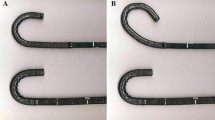Abstract
Background
There is more to a high-quality colonoscopy than reaching the cecum or finding adenomas. Gentle insertion involves ancillary techniques, some of which are impossible in patients receiving deep sedation. The aim of this study was to assess the importance of ancillary techniques in achieving a comfortable, complete colonoscopy.
Methods
This was a prospective study of 500 consecutive outpatient colonoscopies performed by a single endoscopist. During the procedure, note was taken of various ancillary techniques used to facilitate insertion: turning the patient, patient holding their breath, abdominal pressure. The success of these techniques in helping scope advancement was also noted. After the procedure the patient was asked to rate the severity of their pain and their degree of satisfaction with the examination.
Results
A total of 238 women and 262 men participated in the study, and colonoscopy was complete in 96.2 and 98.5 %, respectively. Overall, 97 % of patients received versed alone (average dose 2 mg), and 3 % received a narcotic (average dose 46 U). Average pain score was 3.9 on a scale of 1 (least pain) to 10 (worst pain), and average satisfaction with the procedure as a whole was 9.5 on a similar scale. Ancillary techniques of holding breath, directed abdominal pressure, and turning to the left, right, and prone were used in 46, 56, 17, 23, and 4 % of examinations, respectively. Each technique was effective in helping insertion in over 70 % of cases. Turning the patient was also used to clear stool, open the colon, or facilitate polypectomy in another 33 cases. Multiple techniques were used in 49 % of patients.
Conclusion
The use of ancillary techniques to facilitate colonoscope insertion helps avoid the expense and potential side effects of deep sedation.
Similar content being viewed by others
References
Church JM (1993) Ancillary colonoscope insertion techniques: an evaluation. Surg Endosc 7:191–193
Leung FW, Aharonian S, Guth PH, Jackson G, Chu SK, Nguyen BD et al (2008) Unsedated colonoscopy: time to revisit this option? J Fam Pract 57(12):E1–E4
Petrini JL, Egan JV, Hahn WV (2009) Unsedated colonoscopy: patient characteristics and satisfaction in a community-based endoscopy unit. Gastrointest Endosc 69(3 Pt 1):567–572
Leung FW (2008) Methods of reducing discomfort during colonoscopy. Dig Dis Sci 53(6):1462–1467
Shinya H, Cwern M, Karlstadt R (1982) Colonoscopy: technique and training methods. Surg Clin North Am 62:869–876
Webb WA (1991) Colonoscoping the “difficult” colon. Am Surg 57:178–182
Shah SG, Saunders BP, Brooker JC, Williams CB (2000) Magnetic imaging of colonoscopy: an audit of looping, accuracy and ancillary maneuvers. Gastrointest Endosc 52:1–8
Shah SG, Brooker JC, Thapar C, Williams CB, Saunders BP (2002) Patient pain during colonoscopy: an analysis using real-time magnetic endoscope imaging. Endoscopy 34:435–440
Garrett KA, Church J (2010) History of hysterectomy: a significant problem for colonoscopists that is not present in patients who have had sigmoid colectomy. Dis Colon Rectum 53(7):1055–1060
Roberts-Thomson IC, Teo E (2009) Colonoscopy: art or science? J Gastroenterol Hepatol 24(2):180–184
Kravochuck S, Gao R, Church J (in press) Differences in colonoscopy technique impact patient care. Surg Endosc
Disclosure
X. Xhaja and J. Church has no financial or business affiliations to disclose.
Author information
Authors and Affiliations
Corresponding author
Rights and permissions
About this article
Cite this article
Xhaja, X., Church, J. The use of ancillary techniques to aid colonoscope insertion. Surg Endosc 28, 1936–1939 (2014). https://doi.org/10.1007/s00464-014-3418-9
Received:
Accepted:
Published:
Issue Date:
DOI: https://doi.org/10.1007/s00464-014-3418-9




